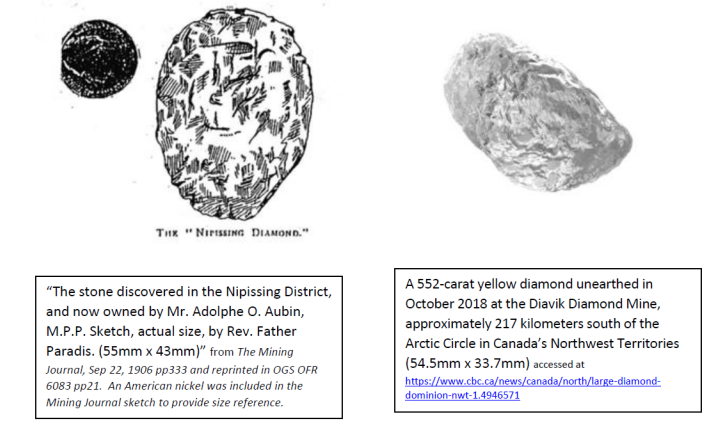ONTARIO DIAMONDS
The first Canadian diamond was found in 1920 by an Ontario worker digging a railroad cut in till for a new railway line near Peterborough (aka Peterboro) Ontario, Canada.
Diamonds are a natural crystalline mineral; the transparent form of pure carbon. They were formed under intense pressure billions of years ago approximately 150 kilometres below the surface within the Earth’s mantle. Carbon was squeezed under tremendous heat and pressure transforming it into hard, clear diamond crystals. Millions of years after diamonds were formed volcanoes acted like elevators carrying them from deep within the earth up through rocky carrot-shaped pipes to the surface. Glaciers, streams and rivers then transported the diamonds further afield.
Although beautiful, rare and durable, diamonds are used for more than gemstones. Being the hardest substance on earth they have many uses such as in dental drills and surgical scalpels. This mineral is used in protective eyewear, computer chips and construction tools. Natural diamonds were even used to make a tiny window in the pioneer spacecraft that travelled to Venus in 1978. In short, most diamonds are 3 billion years old; on the Mohs hardness scale they are the hardest (10); diamonds are better heat conductors than copper; they are measured by their weight in carats with one carat equal to 1/100th of an ounce. The birthstone of April, the average engagement ring diamond weighs less than one carat.
Although earlier you read that the first Canadian diamond was found in 1920 near Peterboro, between 1903 and 1904 (another source says 1903-1905) an “extraordinary” diamond was found near Cobalt, Ontario, Canada on the west side of Lake Timiskaming. Perhaps this was overshadowed by the current silver rush in the area due to the discovery of silver by, you guessed it, railway workers. Known as the Nipissing Diamond, it seems to have a more human-interest story than the Peterboro diamond.
The Nipissing diamond was not widely known in part due to the silver rush and in part the need for secrecy. Named after the district in which it was found apparently it remains one of the largest diamonds ever discovered.
In 1842 the Geological Survey of Canada was founded in Montreal. (See the Madoc Meteorite for more about the GSC.) Its initial mandate was the discovery and development of coal deposits. The first diamonds found in North America were in post-glacial regolith (sand, gravel, boulders) and had been transported by glacial ice sheets or glaciers.
In 1906 Mr. Adolphe Aubin, an Ontario Member of Provincial Parliament (M.P.P.) for the District of Nipissing visited the Tiffany diamond company with an 800 carat, slightly yellow-tinted diamond the size of a hen’s egg for evaluation and cutting. The Nipissing diamond measured 55×43 mm (2.16” x 1.69”) and actually weighed between 792 -836 carats. By comparison, the Peterboro diamond was 33 carats of “rough, broken and low value stone”. Apparently it had little value. Then, in 2018, a 552-carat yellow diamond, nearly the same shape and texture as the Nipissing diamond, was found at the Canadian Diavik Mine. (See photo)
A Roman Catholic priest, Father Paradis, claimed that the Nipissing diamond was found near Cobalt. He has been credited by a number of sources, including David Ramsay, former Minister of Ontario Natural Resources, as the one who found this diamond. Historical records state that a settler found this diamond. Father Paradis was also a settler and a well-known prospector.
Of interest, M.P.P. Mr. Aubin’s ‘Certificate of Registration of Death- District of Nipissing, March 27, 1932’ states his father’s name as ‘Jean B. Aubin (Paradis)’. Apparently the father/husband in a French Canadian family also lists their mother’s maiden name.
Were the M.P.P. and the priest related?
